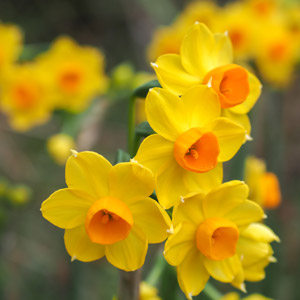
Tulips might smell like dessert to a squirrel or deer, but one bulb that no yard critter likes is the daffodil. These long-lived European natives are poisonous when eaten, a trait that keeps rodents from digging them and rabbits and deer from snacking on their buds. You won’t need fencing or repellents to grow these.
Daffodils have distinctive cup-and-saucer-shaped flowers that bloom from late winter to mid-spring, depending on the variety. They bloom mainly in gold, yellow, or white with a few pastel shades available. Some members of this Narcissus family offer a mild, sweet fragrance, especially the poeticus, tazetta and jonquilla types. These virtues make it easy to understand why of all of the bulb choices, many early European settlers sewed daffodil bulbs into the hems of their dresses to bring to America.

Planting daffodils
As with all spring bulbs, daffodils need “chill time” over winter to trigger flowering in spring. That’s why daffodil bulbs are best planted in fall, starting in late September in northern zones, in October in Zones 5 and 6, and mid-November to mid-December in Zones 7-9. Plant the pointy end up in well drained soil (raised beds are ideal) about three times as deep as the bulb’s height. Cover with soil, and water well. Roots will grow that fall, but the leaf and flower shoots will wait until the right time to poke up in spring.
Be kind to your daffs

Fertilizing each spring and fall with fertilizer high in natural and organic nutrient content maximizes bulb performance. Another helpful practice is to avoid cutting daffodil foliage until it browns or at least begins to yellow in late spring. Premature cutting of the leaves short-circuits the bulb’s attempt to recharge itself via the sun’s energy. Daffodil bulbs also can be dug, divided and replanted right after cutting back the spent foliage in spring.